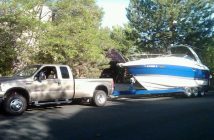The big Miami shows just opened with a new emphasis on high-tech, artificial intelligence and power and more power. Mercury introduced a brand new 400-hp outboard, it’s most powerful yet for recreational use, while Volvo teamed up with Tiara to launch a new outboard version of its revolutionary IPS pod drives for inboards (see the picture at top), and Raymarine showed off its artificial intelligence assisted docking system that I just tested – and I’m still smiling.
To celebrate Mercury’s 80th anniversary, Mercury President John Pfeifer unveiled the new 400-hp Verado, which he said was an upgrade from the 350-hp Verado, “our most popular ever.” Mercury already has a highly tuned 400-hp racing outboard, but Pfeifer said “this is for a much wider range of boats.” Most people “want quiet and no vibration when they run at slow speeds through a marina,” he said, “and this offers all that.” And it only weighs 700 pounds.
For their part, Tiara and Volvo launched a new Tiara Sport 38 LS with two massive 527-hp Seven Marine outboards (Volvo bought Seven Marine two years ago). The news here is that the outboards work with Volvo’s Electronic Vessel Control joystick, so that you drive the boat the same way you’d drive a Volvo IPS inboard boat. The massive outboards use Volvo’s DuoProps to deliver more blade area than any other outboard. They provide much more torque and low-speed maneuvering ability, all controlled from a joystick on an armrest at the helm. This show marked exactly 15 years from when Volvo first introduced its IPS system – and that too was on a Tiara 38; I tested that for three days after the show and knew it was the wave of the future.
I just came back from testing Raymarine’s new DockSense system on a Boston Whaler 330 Outrage with two 300-hp Mercury outboards. This is truly fool-proof docking, and it too is the wave of the future; it is only “assisted docking” at the moment, but there is no doubt that it will lead to truly autonomous docking before too long. The system is based on five FLIR cameras facing fore, aft and port and starboard. It took the engineers 18 months to work out the kinks, but sensors allow you to set up a virtual bumper around the boat – three feet say – so that when you back into a slip, or slide toward a piling, the engines engage to keep the boat three feet away.
And it works. I just tried it and found that a side wind was pushing the boat toward a piling on the lee side – until we got three feet away. Then the boat stopped, or stayed where it was, safe and sound. Then I engaged the large DockSense control button on the helm and the boat backed into its slip without any fuss. Do I ever like that. We’ll have much more from the two shows later. For more:




